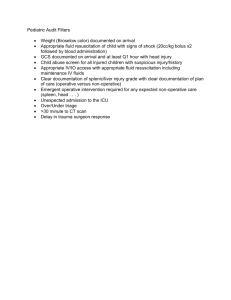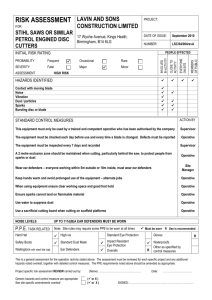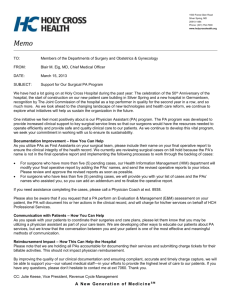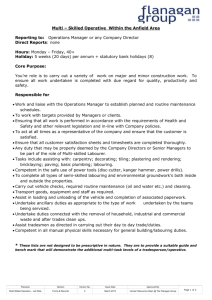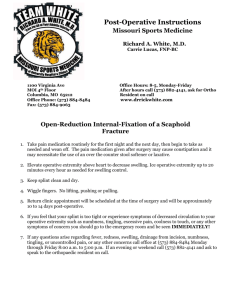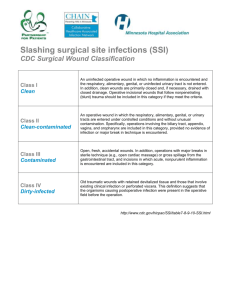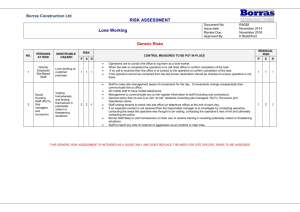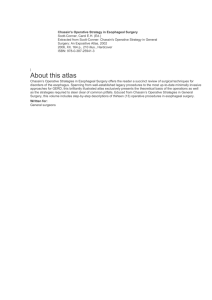Hong Kong Private Practice Survey
advertisement
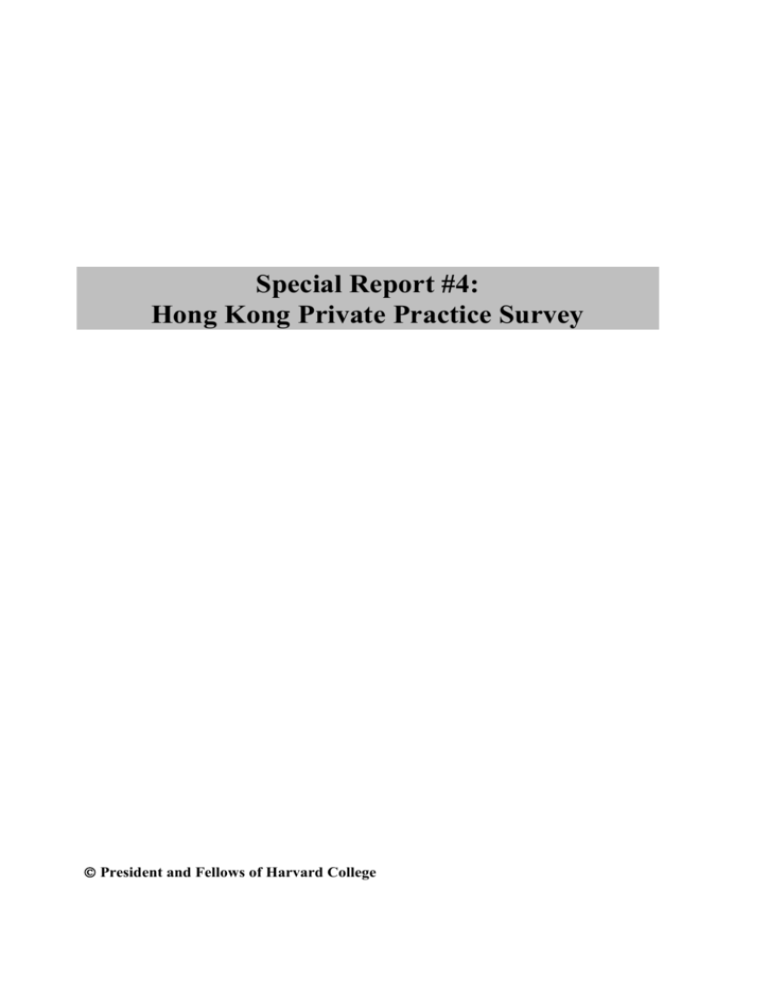
Special Report #4: Hong Kong Private Practice Survey President and Fellows of Harvard College Team members of this report School of Public Health, Harvard University Professor Winnie Yip Professor William Hsiao Anupa Bir Hong Kong Medical Association Dr. Kin-Hung Lee Dr. Kai Ming So And Council Members The private practice survey was conducted jointly by the Hong Kong Medical Association and Harvard University in 1998. The primary objective of the survey is to provide up-to-date, fair and accurate descriptions of private practices in Hong Kong. This information is important background information to the overall study of the strengths and weaknesses of the Hong Kong health care system, as well as to the development of viable alternative financing and delivery options. The survey collected information on practice capacity, payment arrangements, practice expense, charges, referral patterns and views about participation in managed care. The specific questions that the private provider survey attempts to answer include: 1. What is the capacity of the private sector to treat more patients? 2. Given practice expense patterns, what volume and fee level need to be assured in order for private practice to survive? 3. How, and to what extent, does communication take place between public and private providers? 4. To what extent has managed care and contract medicine penetrated into private practice? Other than findings for the entire sample, results were also presented separately for generalists and specialists, and for Estate Doctors Association (EDA) members and non-members. In instances where differences between the mean and median are large, both are reported.1 Of approximately (3800) members of the Hong Kong Medical Association in private practice who received the survey, 603 responses were received. The response rate is 16%2. Given the relatively low response rate, the generalizability of the results should be interpreted with caution. Nonetheless, this survey provides information on the major areas of private practice that does not exist at present in Hong Kong. 1. Background The physicians who responded to this survey had an average of 13 years of experience in private medical practice. Almost half, 44% reported practicing as general practitioners only, 24 % practiced in a specialty only, and 32% practiced in both general medicine and specialty care. Of those who only practiced as specialists, the most frequently reported specialties were Pediatrics, Obstetrics and Gynaecology, Opthamology, Orthopedics, and Psychiatry. The physicians who reported both general and specialty practices had different specialties. The most common ones being Family Medicine, Pediatrics, General Surgery and Internal Medicine. 1 2 This means that the distribution of the variable in interest is skewed. The 1996 HKMA Survey on Physicians’ Fees had a response rate of 20%. 3 Report #4: Private Practice Survey Other than being members of HKMA, 40% of the respondents were also members of the Estate Doctors Association, and 18% were members of other associations, including Practicing Estate Doctors Association, Chinese Doctors Association, and the Public Doctors Association. Eighty two percent of respondents practiced in one private clinic, while 15% practiced in 2 clinics. Most physicians report that they are in solo practice (80%), while 11% are in multispecialty practice and 7% in a single specialty practice. Almost all (93%) of EDA doctors are in solo practice as compared to 77% of non EDA doctors (Tables 1a and 1b). 2. Practice Capacity The sample of private physicians responded that they worked an average of 40 hours per week, seeing an average of 36 patients daily. More than 80% of physicians expressed that they would like to see more patients. On average, they would like to see 60 more patients a week. Consistent with expectation, generalists had higher patient volume than specialists. Generalists worked 46 hours per week, and saw 44 patients per day. In comparison, specialists practiced 35 hours per week and saw 30 patients per day. Generalists responded that they would like to see 77 more patients per week, while specialists would like to see 51 more patients per week (Table 1a). EDA doctors tend to have higher patient volume than non-EDA doctors, partly because more of the responding EDA doctors were generalists. EDA doctors worked an average of 46 hours a week and saw 46 patients per day. Non-EDA doctors worked on average 36 hours per week and saw 30 patients per day. While 80% of non-EDA doctors said that they would like to see more patients, 88% of EDA doctors would like to see more patients. The number of patients that EDA respondents would like to see more are significantly higher than those for non-EDA doctors, 87 compared to 45 per week (Table 1b). 3. Financial Arrangement This information was of particular interest when the survey was designed, as there was relatively little known about the newer payment arrangements private practice face, and the degree to which they are being adopted. The survey specifically collected information on the following types of financial arrangements (see attachment): Fee for service in which patients pay directly out-of-pocket without any insurance or medical benefits coverage; 4 Report #4: Private Practice Survey Medical insurance provided by a third party which reimburses the physicians their usual fees (e.g. HSBC Medical Insurance, National Mutual, BUPA, etc., excluding contract medicine); Contract medicine with employer negotiated fee schedule (e.g. Hong Kong Bank, Jardines, Swire, etc.); Contract medicine with discounted fees; Contract m4edicine with prepaid medical scheme. Fee-for-service Fee-for-service still accounted for the biggest patient share for most private practices. All physicians in the sample had patients who paid out-of-pocket and they represented about 70% of the patient share (Tables 2a and 2b). Medical Insurance Approximately 90% of the physicians in the sample had patients who were covered by medical insurance. Among these physicians, 10-15% of their patients was covered by such insurance. Although non-EDA physicians were more likely to be covered by medical insurance than EDA doctors, the differences were not statistically significant. Contrary to expectation, physicians report that only 70-80% of their usual charges was reimbursed by these insurance schemes (Tables 2a and 2b). Direct contract with employers Approximately 60% of the responding physicians had direct contract with employers who usually reimburse them on a fee-for-service basis. These contracts covered about 10% (median) of their patients, and they covered a larger share of patients for non-EDA than for EDA practices. Such contracts usually reimbursed only 50-60% of the usual charges of the physicians (Tables 2a and 2b). Contracts: discounted fees Discounted fees and prepaid schemes are more recent forms of payment arrangements between physicians and payers in Hong Kong and they cover a smaller proportion of practicing physicians. About 40% of physicians responded that they had discounted fee contracts. EDA doctors tend to be more likely to have such contracts than non-EDA doctors (50 vs 35%). However, such contracts only covered about 10% of physician total practice volume and they reimbursed about 50% of physicians’ usual fees (Tables 2a and 2b). 5 Report #4: Private Practice Survey Contracts: prepaid Under prepaid contracts, physicians are paid a pre-agreed sum of money in advance to provide care for a number of patients. Only about less than 20% of the sample was covered by prepaid contracts. These contracts reimbursed only about half of the physicians’ usual fees. However, specialists in the sample reported that only 35% of their usual fees were reimbursed (Tables 2a and 2b). 4. Practice Expense The total monthly expenditure reported is approximately HK$100,000. Although expenses for specialists are slightly higher than for generalists, they are not statistically significant. About 30% is spent on rent, 30% on medical supplies, and 30% on staff salary (Tables 3a and 3b). 5. Current Charges and Trends Table 4a presents mean and median charges by generalists and specialists. There are noticeable and statistically significant differences in charges by class of bed. Wherever there are significant sample sizes, charges for generalists and specialists are compared. As expected, specialists charge significantly higher prices than generalists. Table 4b presents charges for EDA and non-EDA doctors. For almost all cases for second and third class beds, EDA charges are significantly lower than non-EDA charges. Table 4c compares charges for years 1996 and 1998 for generalists and specialists. Over time, charges have remained relatively stable, with some minor drops for GPs and increase for SPs. 6. Referrals In the analysis of care in the health care system in Hong Kong, the interface between the public and private sectors has been carefully examined. Any patient being referred from one physician or institute to another relies on the information being transferred in order for informed decisions to be made. This section of the survey collected information on referral practices. Overall, responding physicians refer about 8 patients a month to public MDs or institutions. Among the referring physicians, more than 50% of them receive reports from the referred physicians less than 7-10% of times. The majority waited until the patients return next time to find out the results of referral. On the contrary, referred physicians in the private are 6 Report #4: Private Practice Survey much more likely to report back to the referring physicians. The most common form of communication between referral is through written letter. This implies that the quality (e.g. thoroughness, clarity, etc) of the letter is critical in the referral system of Hong Kong. Referral patterns between generalists and specialists, and EDA and non-EDA doctors are relatively similar (Tables 5a and 5b). 7. Attitudes and reactions to managed care The majority of respondents (76%) feel threatened by managed care. The most commonly cited reason for participating in managed care is to increase patient load (~70%). On the other hand, the most commonly cited reasons for NOT participating in managed care plans are low financial reimbursement and the fear of loss of autonomy (Tables 6a and 6b). 7 Report #4: Private Practice Survey Table 1a. PRACTICE INFORMATION Q. no. 7 8 9 9b 10a 10b 10c Survey question How many hours/wk do you practice in all clinics? How many patients/day do you see in all clinics? Would you like to see more patients/week? Yes(%) How many more patients would you like to see weekly? Type of practice: Solo Single specialty partnership Multispecialty partnership GPs mean 46 44 86% 77 SD 15 26 87 87% 4% 10% Specialists mean 35 30 80% 51 SD 14 29 63 80% 10% 11% Table 1b. PRACTICE INFORMATION Q. no. 7 8 9 9b 10a 10b 10c Survey question How many hours/wk do you practice in all clinics? How many patients/day do you see in all clinics? Would you like to see more patients/week? Yes(%) How many more patients weekly? Type of practice: Solo Single specialty partnership Multispecialty partnership 8 EDA mean 46 46 88% 87 93% 0.2% 13% SD 16 29 96 non EDA mean 36 30 79% 45 SD 14 26 56 77% 10% 15% Report #4: Private Practice Survey Table 2a. PAYMENT ARRANGEMENTS 11 Are you a paid-salary staff of any private clinic? 12 Do you share profit in any private clinic? 13 What % of all patients pay fee-for-service (out-of-pocket)? 14 What % of all patients are covered by medical insurance? 15 What % of your charges are reimbursed by medical insurance? 16 What % of patients are covered by direct employer contracts? 17 What % of your charges are reimbursed by direct employer contracts? 18 What % of patients are covered by discounted FFS contract? 19 What % of your charges are covered by discounted FFS contract? 20 What % of patients are covered by prepaid contract? 21 What % of your charges are reimbursed by prepaid contract? NA: the question does not apply to the respondent GPs (%) Mean SD 13 Median NA Specialists (%) Mean SD Median 10 NA 19 68 28 80 16 69 24 75 15 18 10 17 18 10 64 40 80 12 59 40 70 9 19 24 10 41 13 17 8 40 51 33 60 38 48 32 50 44 14 14 10 62 12 15 5 53 47 28 55 55 43 30 50 63 16 18 10 78 17 17 10 79 54 34 60 80 40 32 35 8 Median NA Non-EDA (%) Mean SD Median 13 Table 2b. PAYMENT ARRANGEMENTS 11 Are you a paid-salary staff of any private clinic? 12 Do you share profit in any private clinic? 13 What % of all patients pay fee-for-service (out-of-pocket)? 14 What % of all patients are covered by medical insurance? 15 What % of your charges are reimbursed by medical insurance? 16 What % of patients are covered by direct employer contracts? 17 What % of your charges are reimbursed by direct employer contracts? 18 What % of patients are covered by discounted FFS contract? 19 What % of your charges are covered by discounted FFS contract? 20 What % of patients are covered by prepaid contract? 21 What % of your charges are reimbursed by prepaid contract? NA: the question does not apply to the respondent 9 EDA(%) Mean SD 9 NA 13 72 24 80 20 68 27 75 12 14 8 19 20 10 66 42 84 12 58 39 70 10 14 20 5 43 17 21 10 40 52 34 60 45 51 32 50 43 11 11 8 48 15 17 10 65 45 27 50 49 45 30 50 66 21 20 15 78 14 16 7 79 48 32 60 81 47 34 50 80 Report #4: Private Practice Survey Table 3a. PRACTICE EXPENSE 22 23 24 25 Total monthly expense for your practice (HK$) % of total expenses spent on rent % of total expenses spent on medical supplies % of total expenses spent on staff salary GPs (%) Mean SD 96527 92904 31 15 30 23 28 14 Median 80000 30 30 25 Specialists (%) Mean SD 119017 129177 29 23 32 17 27 12 Median 100000 30 30 25 Table 3b. PRACTICE EXPENSE 22 23 24 25 Total monthly expense for your practice (HK$) % of total expenses spent on rent % of total expenses spent on medical supplies % of total expenses spent on staff salary.. EDA (%) Mean SD 113480 99155 Median 80000 non EDA (%) Mean SD 115600 132698 Median 90000 28 30 27 25 25 25 32 31 28 30 30 25 14 24 13 10 24 17 13 Report #4: Private Practice Survey Table 4a. CHARGES 26a1 26a2 26a3 hospital daily charge 1 class hospital daily charge 2 class hospital daily charge 3 class GPs (HK$) Mean SD 1092 598 745 289 514 227 26b1 26b2 26b3 bedside procedure charge 1 class bedside procedure charge 2 class bedside procedure charge 3 class 1853 1318 922 26ci1 26ci2 26ci3 ultra major operative procedure 1 class ultra major operative procedure 2 class ultra major operative procedure 3 class NA NA NA 70347 48077 38170 42094 25749 78589 60000 45000 30000 26cii1 26cii2 26cii3 major operative procedure 1 class major operative procedure 2 class major operative procedure 3 class NA NA NA 42338 28502 18104 25403 15181 9157 38000 25000 15000 26ciii1 26ciii2 26ciii3 intermediate operative procedure 1 class intermediate operative procedure 2 class intermediate operative procedure 3 class NA NA NA 26160 17669 11974 17762 12170 9320 21000 15000 10000 26civ1 26civ2 26civ3 minor operative procedure 1 class minor operative procedure 2 class minor operative procedure 3 class 3249 2471 1754 2476 1680 1145 2500 2000 1500 8229 6376 3619 6076 8313 2178 7500 5000 3200 27ai 27aii 27aiii1 27aiii3 GP average charge- regular consultation GP average charge- extended consultation GP average charge- simple procedure GP average charge- complex procedure 186 247 327 1125 75 118 234 821 170 200 270 1000 250 336 486 1657 112 182 451 1276 200 300 300 1000 27bi 27bii 27biii1 27biii3 Specialist average charge -regular consultation Specialist average charge -extended consultation Specialist average charge -simple procedure Specialist average charge -complex procedure NA NA NA NA 430 616 777 2988 190 326 671 3853 400 500 600 2000 18 13% 2% 20 28 number of patients you ordered labs/xrays for/wk 17 29 do you own lab facilities 16% 30 is your clinic located in a public housing estate 26% Note: refer to survey for description of procedure types. NA: sample size too small to calculate valid summary statistics. 11 1104 785 532 25 Median 1000 700 500 Specialists Mean 1598 976 602 (HK$) SD 685 363 249 Median 1500 900 600 1500 1000 800 3570 2758 1568 2682 3235 1198 3000 2000 1000 Report #4: Private Practice Survey Table 4b. CHARGES 26a1 26a2 26a3 hospital daily charge 1 class hospital daily charge 2 class hospital daily charge 3 class EDA (HK$) Mean SD 1142 423 765 231 512 158 26b1 26b2 26b3 bedside procedure charge 1 class bedside procedure charge 2 class bedside procedure charge 3 class 2471 1744 1284 26ci1 26ci2 26ci3 ultra major operative procedure 1 class ultra major operative procedure 2 class ultra major operative procedure 3 class NA NA NA 26cii1 26cii2 26cii3 major operative procedure 1 class major operative procedure 2 class major operative procedure 3 class 30669 21816 13584 18204 11254 6024 30000 20000 12000 44382 29697 18785 25698 15359 9288 40000 26500 16000 26ciii1 26ciii2 26ciii3 intermediate operative procedure 1 class intermediate operative procedure 2 class intermediate operative procedure 3 class 17394 11572 7408 10078 5128 3145 15000 10000 8000 26949 18284 12192 18025 12436 9572 22000 15000 10000 26civ1 26civ2 26civ3 minor operative procedure 1 class minor operative procedure 2 class minor operative procedure 3 class 4777 3468 2254 2982 2023 1271 4000 3500 2000 8342 6562 3659 6560 8714 2344 8000 5000 3000 27ai 27aii 27aiii1 27aiii3 GP average charge- regular consultation GP average charge- extended consultation GP average charge- simple procedure GP average charge- complex procedure 174 223 327 1155 51 79 243 899 170 200 250 900 247 342 453 1471 115 181 415 1121 215 300 350 1000 27bi 27bii Specialist average charge -regular consultation Specialist average charge -extended consultation Specialist average charge -simple procedure Specialist average charge -complex procedure 309 417 111 191 300 400 453 649 193 330 400 500 553 1881 424 1283 455 1500 828 3128 730 3689 600 2000 20 25 27biii1 27biii2 28 number of patients you ordered labs/xrays 14 for/wk 29 do you own lab facilities 14% 30 is your clinic located in a public housing estate 27% Note: refer to survey for description of procedure types. NA: sample size too small to calculate valid summary statistics. 12 2051 130 1004 16 Median 1000 800 500 non EDA (HK$) Mean SD 1602 735 977 378 603 268 Median 1500 900 600 2000 1500 1000 3463 2679 1464 2618 3274 1134 3000 2000 1000 71646 48898 31043 41001 25844 14020 60000 45000 30000 16% 3% Report #4: Private Practice Survey Table 4c. CHARGES OVER TIME 26a1 26a2 26a3 hospital daily charge 1 class hospital daily charge 2 class hospital daily charge 3 class 1996 GP Median 1200 800 400 26b1 26b2 26b3 bedside procedure charge 1 class bedside procedure charge 2 class bedside procedure charge 3 class 2500 1500 1000 1500 1000 800 2750 1900 1000 3000 2000 1000 26ci1 26ci2 26ci3 ultra major operative procedure 1 class ultra major operative procedure 2 class ultra major operative procedure 3 class 70000 30000 20000 NA NA NA 60000 40000 25000 NA NA NA 26cii1 26cii2 26cii3 major operative procedure 1 class major operative procedure 2 class major operative procedure 3 class 27500 15000 10000 NA NA NA 35000 20000 15000 NA NA NA 26ciii1 26ciii2 26ciii3 intermediate operative procedure 1 class intermediate operative procedure 2 class intermediate operative procedure 3 class 15000 9500 5000 NA NA NA 20000 13000 8000 NA NA NA 26civ1 26civ2 26civ3 minor operative procedure 1 class minor operative procedure 2 class minor operative procedure 3 class 5000 3500 2200 2500 2000 1500 8000 5000 3000 7500 5000 3200 27ai average charge- regular consultation 150 27aii average charge- extended consultation 200 27aiii1 average charge- simple procedure 300 27aiii3 average charge- complex procedure 1000 NA: sample size too small to calculate valid summary statistics. 180 230 300 1000 350 500 600 2000 400 500 500 2000 13 1998 GP Median 1000 700 500 1996 SP Median 1450 800 500 1998 SP Median 1500 900 600 Report #4: Private Practice Survey Table5a Referral 31 32 33a 33b 33c referrals/ month to public institution/MD for what % did you receive reports from ref MD did you try to find out from family (%) did you wait until patients next visit (%) did you try to contact the referred MD (%) GPs (Mean|Median) 10.7 20 7 41 88 7 34 35 36a 36b 36c referrals/ month to private institution/MD for what % did you receive reports from ref MD did you try to find out from family (%) did you wait until patients next visit (%) did you try to contact the referred MD (%) 7.7 74 29 74 33 37 37a 37b 37c 37d 37e how do you transfer patient records when referred sent copy to referred MD (%) gave copy to pt to take to ref MD (%) sent a letter with a summary of pt conditions (%) contact referred MD by phone (%) other (%) 3 9 90 25 1 7 14 93 42 2 5 12 92 35 1 38 38a 38b 38c what form of patient records do you keep paper? (%) computer? (%) both? (%) 78 4 22 79 2 21 79 3 21 90 Specialists (Mean|Median) 5.7 27 10 38 83 22 Overall (Mean|Median) 8 24 10 39 85 15 6.8 80 28 64 52 7.2 77 28 68 43 90 90 Table5b 31 32 33a 33b 33c referrals/ month to public institution/MD for what % did you receive reports from ref MD did you try to find out from family (%) did you wait until patients next visit (%) did you try to contact the refered MD (%) EDA (mean|med) 10.7 19 5 36 89 6 34 35 36a 36b 36c referrals/ month to private institution/MD for what % did you receive reports from ref MD did you try to find out from family (%) did you wait until patients next visit (%) did you try to contact the refered MD (%) 6.8 73 25 76 30 37 37a 37b 37c 37d 37e how do you transfer patient records when referred sent copy to referred MD (%) gave copy to pt to take to ref MD (%) sent a letter with a summary of pt conditions (%) contact referred MD by phone (%) other (%) 2 11 90 25 1 7 13 93 41 1 5 12 92 35 1 38 38a 38b 38c what form of patient records do you keeppaper? (%) computer? (%) both? (%) 79 3 19 78 3 23 79 3 21 14 90 non EDA (mean|med) 6.2 27 10 41 82 21 Overall (mean|med) 8 24 10 39 85 15 7.5 79 30 63 52 7.2 77 28 68 43 90 Report #4: Private Practice Survey 70 Table 6a. MANAGED CARE REACTIONS Do you feel threatened by managed care- yes(%) GPs 77 Specialists 76 Overall 76 Reasons to participate in contract medicine Increase patient load (%) More regular income and caseload (%) Lower admin burden (%) Reduce overhead (%) Other (%) 74 75 12 13 7 70 80 8 10 12 72 77 9 12 10 Main reasons for refusing to participate Busy enough (%) Concerned about quality of care (%) Feel autonomy will be compromised (%) Financial reimbursement too low (%) Concerned about financial risk (%) Administrative burden (%) Philosophically opposed (%) Other (%) 38 53 63 73 11 22 32 6 42 59 68 78 10 31 41 7 39 57 66 76 10 27 36 7 Do you feel threatened by managed care- yes (%) EDA 85 non EDA 71 Overall 76 Reasons to participate in managed care (%) Increase patient load More regular income and caseload Lower admin burden Reduce overhead Other 77 79 6 11 8 68 76 11 12 11 72 77 9 12 10 Reasons for refusing to participate in managed care (%) Busy enough Concerned about quality of care Feel autonomy will be compromised Financial reimbursement too low Concerned about financial risk Administrative burden Philosophically opposed Other 41 53 62 80 10 21 29 4 38 59 69 73 11 31 41 8 39 57 66 76 10 27 36 7 Table 6b. MANAGED CARE REACTIONS 15 Report #4: Private Practice Survey
